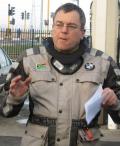Watch out at intersections (and go do FPOS training)
I was on my usual work commute on Friday, sitting behind (I think) a Harley and a road bike, when it was brought home to me (yet again) how important it is to stay awake and aware at intersections.
On Marine Drive, heading towards town, the traffic tends to be jammed in the two left lanes that head to town, while the right-hand lane that eventually turns back to Paarl is clear.
I always slack off massively when approaching robots with jammed traffic, even when the lights are green for me. Often cars or trucks in the on-coming lanes turn right, because all they see at the intersection is stationary traffic and, usually, a nice gap left in the middle of the intersection by traffic-stuck vehicles.
Motorists and truck drivers don't look out for bikers. Pedestrians don't look out for bikers. We have to look out for ourselves.
On that Friday, it was a bunch of 4-5 pedestrians who only saw the two lanes of stationary traffic and one clear one, before making a run for it across the road.
The bikers in front of me weren't speeding, but they hadn't slowed either. They were 'in the right', because the light was green for them, but they were not aware.
It was hectic. You can see what's going to happen and there's nothing you can do. The Harley hit one of the pedestrians. The other biker and I pulled off the road to see where we can help. Another motorist also stopped.
The guy on the Harley seemed a bit sore, but ok. He had not been on the business end of 300 kg of metal. The pedestrian was lying in the middle of the lane, conscious, but not moving.
I have no medical training, but I remembered snippets from Andy's FPOS (First Person On Scene) training. The motorist who had stopped to help had pulled off the road. Yet, there was a guy lying in the middle of the road.
I turned round, rode a short bit 'upstream' from the accident and placed myself broadside across the lane, directing traffic, including the trucks from the port, around the scene.
The weather was grim, so I was wearing my top-to-toe lumo-yellow rain suit. That really helped, and the fact that traffic was on a general go-slow. My biggest worry was other approaching bikers!
The road biker and motorist had summoned the ambulance and made sure the pedestrian did not move.
When the ambulance arrived, it parked broad-side on my spot, so I buggered off. They had a witness in the form of the other biker who had been directly behind the Harley when it happened.
Two take-away messages for me:
1) Be super-aware at intersections, even if traffic is at a standstill. You can blame the pedestrians all you want, but that accident was avoidable.
2) Go for FBOS training. Even if you don't have medical skills, you can still help by knowing what you can do and (importantly) what not to do (e.g. moving the injured person).
Good point Zanie.
I find it useful to "meerkat" when approaching an intersection while lane-splitting. It gives me a better view of the intersection, and it allows others to see me better. I like to imagine drivers thinking "WTF is that biker doing, standing up like that?".
On my commute the most dangerous intersection is a very small one. A side road to the M3 on Wynberg Hill. You'll be happily splitting down a wide gap between the stationary cars without realising that right-turners into the side road can cross your path before you see them.
Wonderful report Zanie,
Thanks for stopping an do not just keeping going.
So glad you found merit in the training an dit kicked in.
Yes, so true! situational awareness is what keeps motorcyclists alive longer.



